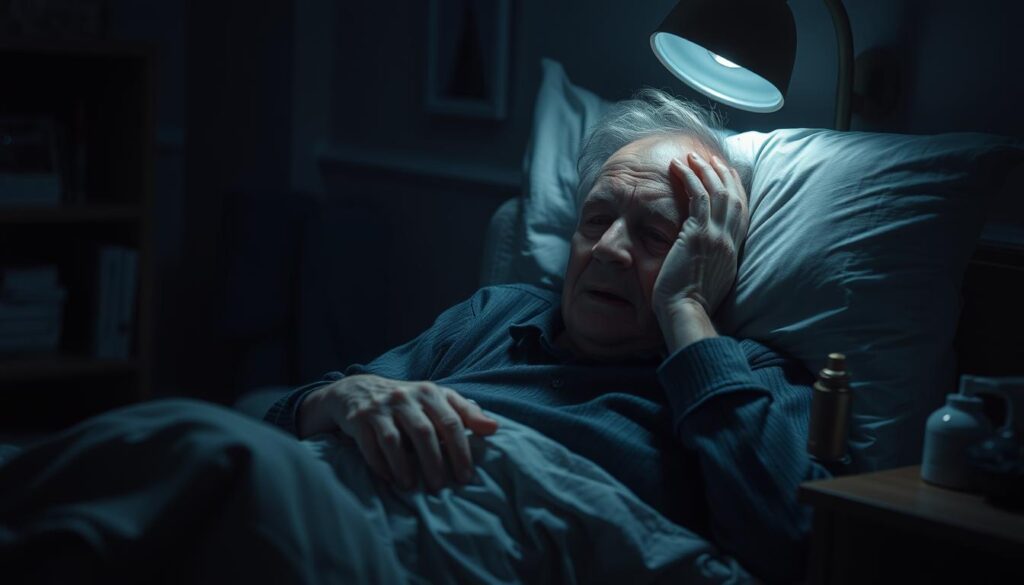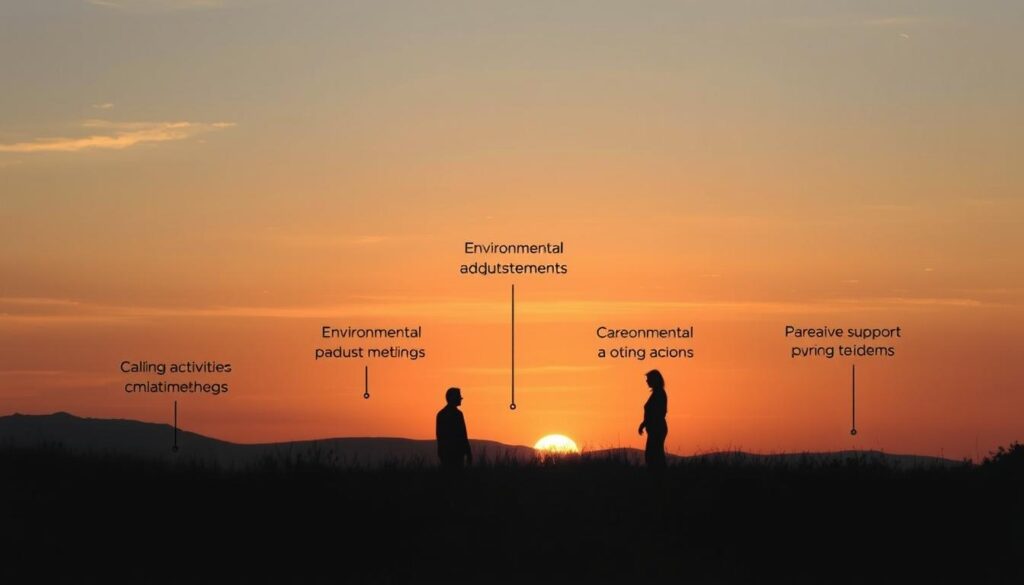- April 28, 2025
Welcome to Dementia World elderly home services



Did you know that up to 66% of people with Alzheimer’s disease show sundowning symptoms? This happens in the late afternoon and evening. It causes confusion, anxiety, and agitation in those with dementia.
As caregivers and loved ones face these challenges, it’s key to understand sundowning. This knowledge helps in providing the right support and care.
When the sun sets, people with dementia show unique behaviours. These changes affect their daily lives and those of their caregivers. Sundowning symptoms start between 4:30 p.m. and 11 p.m., as daylight fades.
This article explores sundowning in dementia. It looks at recognition, causes, and how to manage it. This ensures people and their families can better cope with its effects.
Sundowning syndrome is a condition found in people with dementia. It shows through behavioural changes dementia patients have as the day ends. Symptoms like anxiety, agitation, and hallucinations can worsen during this time.
This issue can happen at any time, but it’s more common in the late afternoon and evening.

About 66% to 75% of people with dementia may face sundowning symptoms. Being alone can make these symptoms worse. Things like changing lights and loud noises can also cause confusion and anxiety.
Having a regular routine and staying connected with others can help. This approach can make a big difference in how patients feel during these tough times.
The time and how long sundowning symptoms last can vary. Changes in the body’s clock, like in fall and winter, can disrupt sleep. It’s important for caregivers to know when these symptoms might happen.
This knowledge helps them manage these difficult moments better.
Sundowning syndrome is a big challenge for caregivers. It’s hard to spot the signs that show it’s happening. Knowing these signs helps caregivers act fast and help their loved ones better.
The signs of sundowning show up in the late afternoon and evening. The main symptoms are:
About 50% of people with Alzheimer’s have sundowning symptoms. This shows how important it is to understand and manage these symptoms.
Caregivers need to tell sundowning symptoms apart from other dementia signs. For example, dementia can cause:
It’s key to know the difference. Sundowning can get worse as Alzheimer’s progresses, due to tiredness and changes in the environment. It’s important to use strategies that help and make the person feel safer and more calm.

The reasons behind sundowning in dementia are complex and not fully known. Many things can make symptoms worse in the evening. This affects people with dementia a lot.
Several factors can cause sundowning, including:
Cognitive decline in dementia plays a big role in sundowning. As thinking skills get worse, people may feel more confused and anxious in the late afternoon and evening.
Studies show symptoms often get worse between 4:30 PM and 11:00 PM. People might look for places they know or say they want to “go home.” This happens a lot in sundowning. With up to 66% of dementia patients affected, managing these triggers is very important.

| Potential Trigger | Impact on Symptoms |
|---|---|
| Physical Discomfort | Increases agitation and confusion |
| Lighting Changes | Triggers feelings of unease |
| Sleep Disruption | Affects mood and cognitive function |
| Environmental Changes | Leads to heightened anxiety |
| Dietary Factors | Can disrupt sleep, worsening symptoms |
The link between dementia and sundowning is complex. It affects patients and caregivers a lot. Dementia changes how the brain works, messing with sleep and wake times. As dementia gets worse, sundowning symptoms get more obvious.
Dementia can mess with our body clocks, making it hard to sleep and wake up right. This can cause sundowning symptoms like anxiety and restlessness. Up to 66% of Alzheimer’s patients might show these signs.
These symptoms can mix with other brain problems, making it harder to manage them.
Circadian rhythms are key to our health and happiness. For people with dementia, these rhythms can make evening hours confusing and anxious. Sundowning symptoms get worse as night falls.
This can make caregivers very tired, affecting how well they can care for patients. It’s important to create supportive places to help with sundowning in dementia.

| Characteristic | Neurological Changes | Sundowning Symptoms |
|---|---|---|
| Cognitive Impairment | Disrupted brain function leading to confusion | Increased anxiety and agitation |
| Circadian Rhythm Disruption | Difficulty regulating sleep patterns | Heightened restlessness during evening hours |
| Caregiver Stress | Emotional and physical fatigue in care providers | Compounded challenges in managing symptoms |
| Prevalence | Common in advanced dementia stages | Reported in up to 66% of Alzheimer’s patients |
Creating effective strategies for sundowning can greatly improve life for those with dementia. A structured daily routine can help reduce confusion and agitation in the late afternoon and evening. Regular times for meals, sleep, and activities bring a sense of familiarity and security.
Having a consistent schedule is key to managing dementia’s behavioural changes. Regular meal, activity, and bedtime times help keep emotions stable. Physical activities can cut down wandering by 40%.
Music therapy is also effective, reducing agitation in 75% of patients during daily routines. Caregivers should keep a calm and reassuring environment. This helps ease emotional distress.
Environmental changes can greatly impact behaviour. Adjusting lighting and noise levels can make a big difference. Over 70% of caregivers see improvements by reducing overstimulation.
Dimming lights and lowering background noise can create a calming atmosphere. Tools like medical alert systems or wearable ID bracelets can help manage wandering. Below is a summary of useful adjustments.
| Adjustment | Benefit |
|---|---|
| Dimming Indoor Lights | Reduces agitation and promotes feelings of security. |
| Minimising Noise | Limits sensory overload and confusion. |
| Regularly Scheduled Activities | Enhances emotional stability and routine. |
| Music Therapy | Reduces distress during daily tasks by 75%. |
| Medical Alert Systems | Decreases locating time for wandering patients by up to 50%. |

Good communication is key in managing sundowning syndrome in dementia patients. It helps caregivers and those with symptoms have better interactions. Knowing how to read non-verbal cues is also important.
Non-verbal signs like facial expressions and body language are very telling during sundowning episodes. Caregivers need to be aware of these signs to help those with dementia. By noticing these cues, caregivers can offer comfort and support in a gentle way.
It’s vital to comfort those with sundowning syndrome. Here are some ways to do it:
Using these strategies can make individuals feel more at ease during sundowning episodes. Clear and caring communication builds trust, making the care environment better.
| Non-Verbal Cues | Interpretation | Reassurance Techniques |
|---|---|---|
| Frowning | Discomfort or confusion | Gently ask if they need assistance |
| Withdrawal | Overwhelm or fatigue | Offer space but remain nearby |
| Agitated movements | Frustration or anxiety | Speak softly, offer calming reassurance |
| Eye contact | Seeking connection | Engage with gentle touches or smiles |
Stressing the importance of good communication can really help reduce sundowning distress. This improves the care quality for those with dementia.
When sundowning behaviours get too hard to handle, it’s time to get professional help for dementia. Doctors can adjust medications and create special plans for each person. This helps manage sundowning better.
It’s key to talk to a healthcare provider if you notice:
There are many ways to improve life with sundowning without medication. Some include:
Keeping a regular, peaceful routine can help with sundowning. Checking on vision and hearing needs is also important. Trying these treatments can really help improve how people feel.
Understanding sundowning syndrome in dementia is key for caregivers and healthcare workers. It helps them support those with this tough condition better. Knowing the symptoms, like increased agitation and confusion in the evening, leads to better ways to manage it. This can greatly improve life quality for those affected.
Creating a comforting environment is possible with the right approach. This includes being aware of what might trigger these behaviours and using special communication methods. Caregivers can make a big difference here.
Managing sundowning is more than just spotting its signs. It needs ongoing support and help from professionals. Making changes to the living space and sticking to routines can help a lot. It’s also important to use non-verbal cues to ease distress.
In cases of late-stage dementia, where people may find it hard to care for themselves, knowing about sundowning is even more important. It helps keep their dignity and improves their overall well-being.
As we learn more about dementia, tackling sundowning syndrome is a big part of managing dementia. Spending time on education and communication makes a big difference. It not only helps caregivers but also makes those affected feel safer and more reassured.
This approach leads to better healthcare results and more caring care practices for those facing dementia’s challenges.
Sundowning syndrome is a condition seen in people with dementia. It causes more confusion, anxiety, and agitation in the late afternoon and evening. Symptoms like restlessness or hallucinations happen as daylight fades.
Symptoms include irritability, confusion, and emotional distress. People may also pace more. These symptoms worsen in the early evening, making it hard for both the person and their caregivers.
Caregivers can tell sundowning symptoms apart by looking at when and how they happen. Sundowning symptoms show up in the late afternoon and evening. They include specific actions like restlessness or agitation, which are different from general dementia symptoms.
The exact reasons for sundowning syndrome are not known. But possible causes include physical discomfort, side effects from medication, and lack of sunlight. Brain changes in dementia might also play a part.
Dementia can mess with the brain’s internal clock. This leads to more confusion and agitation in the evening. As dementia gets worse, these changes can make sundowning symptoms worse too.
Caregivers can use structured routines and keep meal and sleep times the same. Activities during daylight hours also help. Making the environment calm, like reducing noise and dimming lights, can also help.
Good communication is key in managing sundowning. Caregivers should watch for non-verbal signs and use calm, soothing words. This can help reduce agitation and confusion.
Seek professional help if sundowning behaviours are severe or hard to manage. Healthcare providers can check medications, suggest treatments, and recommend therapies that meet the individual’s needs.
Non-medication treatments include light therapy, music therapy, and environmental changes. These can help reduce confusion and distress. Using these strategies can greatly improve life for those with sundowning.